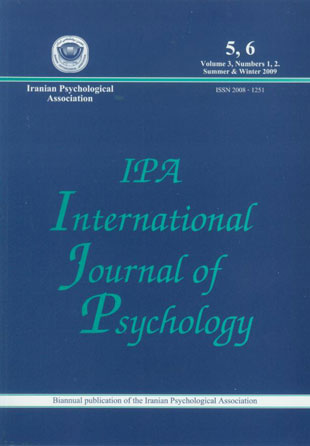فهرست مطالب

International Journal of Psychology
Volume:3 Issue: 1, Winter 2009
- تاریخ انتشار: 1388/10/11
- تعداد عناوین: 8
-
-
Page 1The main purpose of this research was to study the effectiveness of enrichment program training on increasing marital satisfaction and marital intimacy. Research method was quasi- experimental with pre, post and follow-up tests and control group. The statistical population was parents of elementary female students. The sample comprised 30 couples who were randomly selected and randomly assigned to two groups (15 couples to the experimental group and 15 couples to the control group). The experimental group participated in 2-hr sessions for 6 weeks. The data were obtained using Marital Satisfaction Test, and Marital Intimacy Inventory (MII). Results showed that enrichment program training (EPT) was effective on marital satisfaction and its subscales (sexual relationship, conflict resolution skills, community with original family, religious values, and social recreational activities) in both post and follow-up tests (P 0.05). Enrichment program training was not significantly effective in household management (P 0.05). The results of this research indicate that enrichment program training could increase total marital intimacy score and some of its subscales like emotional, intellectual, psychological, communication and social recreational activities. But it could not increase sexual, religious and physical marital intimacy. It can be concluded that enrichment program training can be applied as an effective education to increase the marital satisfaction and intimacy.
-
Page 22The relationship between coping mechanism variables and job burnout variables was examined among the high school teachers from Iran and India, to find out the differences in coping mechanisms and job burnout of the Iranian and Indian teachers, and to study the role of coping mechanisms in job burnout among these teachers. The instruments used to measure the variables were: 1) The Ways of Coping Questionnaire by Lazarus and Folkman (1984) and 2) Maslach Burnout Inventory by Maslach and Jackson (1981). The data were collected from 300 teachers from Iran and 300 teachers from India. 137 female teachers and 163 male teachers were teaching in high schools in Tehran (Iran), and 160 female teachers and 140 male teachers were teaching in high schools in Pune (India). The statistical techniques of descriptive statistics, and two-way ANOVA statistics were employed to analyze the data. The results indicated that: (1) Iranian teachers, compared to the Indian teachers, were higher in the use of problem-focused coping mechanism (p <. 01). But, there were no significant differences between Iranian and Indian teachers in the use of emotion-focused coping mechanism; (2) There were no significant differences between Iranian and Indian teachers on job burnout in the areas of emotional exhaustion and loss of personal accomplishment. However, Indian teachers, compared to the Iranian teachers, were higher on job burnout in the area of depersonalization (p <. 01).
-
Page 43The aim of the current study was to explore the association of parental and child factors with pedestrian skills of Iranian children. The question was whether parental factors such as verbal instructions given to children on road safety, parent''s safe practices in real traffic situations while accompanying their children, and parents'' educational level, or child factors such as age, gender, birth-order and number of siblings are related to the skill of children in identifying safe/dangerous road crossing sites. The pedestrian skills of 127 children at ages 7, 9 and 11 years were assessed by a pedestrian task involving 10 pictures of different crossing sites. The frequency of verbal instructions parents give to their children on road safety and safe road behaviour of parents as pedestrian with their children was assessed by a self-report questionnaire. Results indicated that the most significant predictor was age. Young children were less able to perform the pedestrian task, and measured parental factors did not have any association with children''s safety skill. It seems that Iranian children have to outgrow the limitations set by their developmental level. The measured parental factors did not have any role in doing so. The study suggests that a culture of road safety should be raised in Iran. Children need parents to aware them of road dangers in general and to train them specific skill of identifying safe/dangerous road crossing sites. Therefore, the role of parents as proper pedestrian models should be considered when developing road safety educational programmes for children in Iran.
-
Page 59
The Dysfunctional Attitude Scale (DAS) was designed to measure patterns of maladaptive thinking held by depressed individuals. Despite its wide use as a research and clinical tool, only a few studies have been carried out to examine its psychometric properties in a high school student population in Iran. The objective of this study was to validate the Iranian version of the Dysfunctional Attitudes Scale Form A in the context of Iranian students. A total of 522 Iranian students (275 females and 225 males) from high schools participated in the study and completed a Persian version of General Health Questionnaire (PGHQ) and a Persian version of Automatic Thought Questionnaire (PATQ). Exploratory factor analyses showed a four-factor model of dysfunctional attitude scale which contains perfectionism, social approval, dependency and autonomy. The fit of the proposed four-factor model was not promising. The internal consistency of the DAS (40 items) was reasonable (Cronbach''s α = 0.72).The DAS correlated significantly with the PGHQ (r = 0.28) and the PATQ (r = 0.35). The results of exploratory factor analyses fairly supported the four-factor framework with Iranian students; however, confirmatory factor analysis was not fit with the model. Implications are discussed in detail.
-
Page 78The purpose of this article is to investigate the relationship between organizational culture and organizational identification. Participants included 300 employees from an industrial organization in Ahvaz, Iran, who completed the organizational identification and organizational culture questionnaires. The results showed that there are positive and significant relationships between subscales of organizational culture (i.e., teamwork, morale, informational flow, involvement, supervision, meeting), and organizational identification. The relationships between disidentification, ambivalence and neutral identification with dimensions of organizational culture were negative and significant.
-
Page 96
The purpose of this study was to examine the validity and reliability of the CRI-adult among Iranian university students. This study explored the relationship between the two sub-scales among Iranian university students by using exploratory and confirmatory factor analysis. The results showed that the two factors (Approach and Avoidant Responses) were significantly related to the CRI general factor. The Goodness-of-Fit Index, the Adjusted Goodness-of-Fit Index, and the Root Mean Square Error of Approximation were significant. These indices supported theoretically that the construct of coping responses inventory is psychometrically sound and fit the model. Concurrent validity showed that the score of mental health and its factors such as bodily symptoms, anxiety, disorder in social function and depression correlated with scores of Approach and Avoidant factors. The Cronbach coefficient alpha values and test-retest correlations were acceptable for total scores'' CRI and its subscales. The results showed that the CRI is a reliable and valid measure of assessing coping responses in Iranian university students and it is suggested for the examination of the quality of coping responses among Iranian students.
-
The Moderating Effect of Nationality, Gender, Position, and Tenure on the Relationship between Organizational Citizenship Behaviors (OCBs) and Counterproductive Work Behaviors (CWBs) among Iranian and / Malaysian Automotive Workers: A Cross Cultural StudyPage 120There are two main objectives in this study: first, to measure the relationship between organizational citizenship behaviors (OCBs) and counterproductive work behaviors (CWBs); and second, to determine the moderating effect of nationality, gender, position, and tenure on the relationship between OCBs and CWBs. One thousand and fifty eight participants participated in this study. A set of questionnaires consisting of, demographic information of the respondents which includes nationality, gender, position, and organizational tenure, which used as moderator variables, 16 OCBs questions developed by Lee and Allen (2002), and 45 CWBs questions developed by Fox and Spector (2002) were translated into Persian and Malay languages. The questionnaires were administered by the researchers in Iran and Malaysia. The findings of study showed that OCBs and CWBs are negatively correlated among the total sample (r= -0.207, p<0.01), Iranian sample (r = -0.314, p<0.01), and Malaysian sample (r = -0.108, p <0.05). It was also found that nationality (β = 0.204 p <0.01) and gender (β = -0.07 p <0.05) moderated the relationship between OCBs and CWBs. However, position and tenure did not. Based on these results, it was concluded that, OCBs and CWBs are negatively correlated; moreover nationality and gender moderated the relationship between OCBs and CWBs. The limitations, implications and some suggestions for further studies are also mentioned.
-
Page 146The present study was aimed at studying the relationship between job position and personality in the Indian organizational settings. 283 officers (all men, age: 22-58 yrs) belonging to the middle management of large manufacturing units participated in the study. The officers were grouped into three job positions: Low, middle and high based on their hierarchical position. The participants answered the Neo Five Factors Inventory (NEO-FFI, Costa & McCrae, 1992), and Job in General (JIG, Balzer et al, 2000). The results of multivariate analysis of variance (MANOVA) showed that Job positions differed significantly on neuroticism showing lower neuroticism scores for higher job positions, F(2, 280)= 6.30 p< 0. 01. similar significant results were obtained in the case of agreeableness (F (2, 280)= 9.17 p< 0.001) where higher agreeableness scores were obtained for higher job positions and in the case of conscientiousness showing higher scores for higher job positions (F (2.280)= 6.53 p< 0.01). Extraversion and openness yielded non-significant results.


